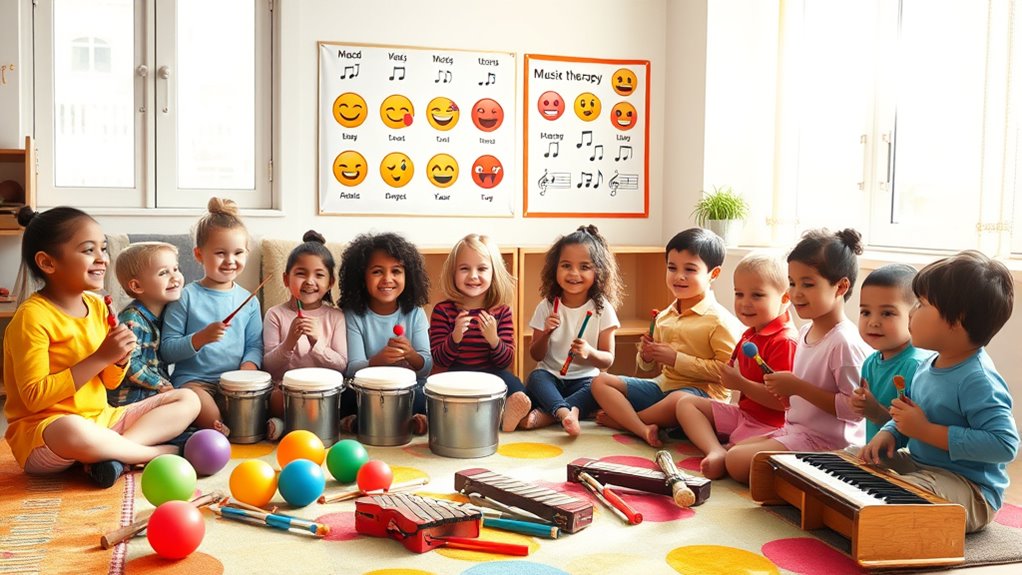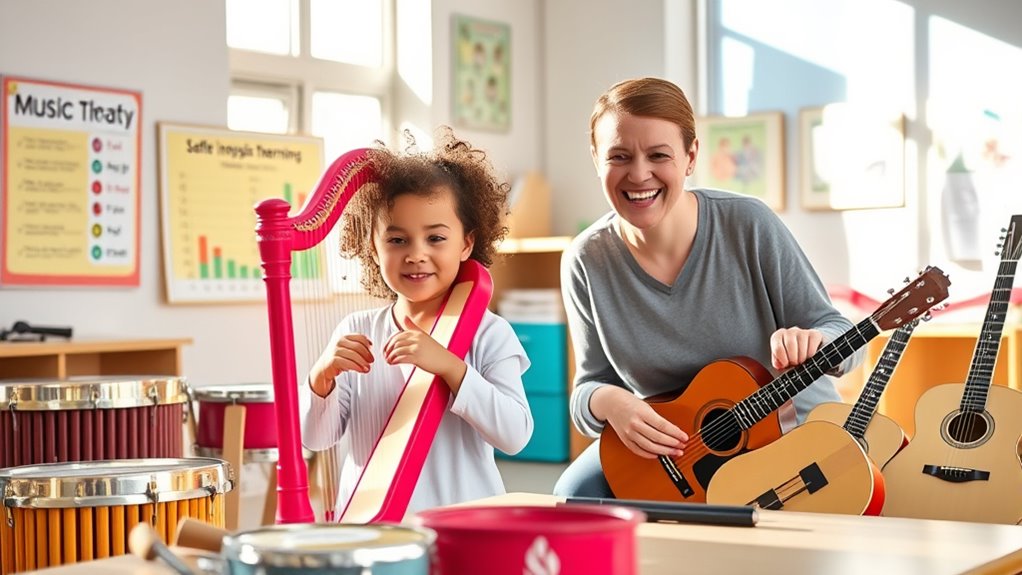Teaching kids about music therapy and mood improvement helps them discover how music can express and regulate feelings. By engaging with instruments and improvisation, children learn to explore emotions safely and creatively. This process boosts self-awareness, emotional intelligence, and social skills. Sharing musical experiences encourages teamwork and healthy emotional responses. If you’re curious about practical ways to use music for emotional growth, you’ll find more helpful insights as you continue exploring this engaging approach.
Key Takeaways
- Explain how music therapy helps children express and regulate emotions through creative musical activities.
- Demonstrate using instruments and improvisation to show how music influences mood and emotional awareness.
- Incorporate collaborative musical exercises to develop social skills and emotional understanding.
- Highlight the calming and energizing effects of different musical sounds to teach mood management strategies.
- Use real-life examples to illustrate how music therapy fosters emotional resilience and self-awareness in kids.

Music therapy is a powerful tool that can help improve mood and emotional well-being, especially for kids. When you introduce children to musical instruments, you’re opening a doorway for them to explore their feelings and express themselves in unique ways. Playing instruments like drums, keyboards, or guitars allows kids to channel their emotions creatively and constructively. As they learn to handle these instruments, they gain a safe outlet for emotional expression, which can be particularly helpful during challenging times or when words aren’t enough.
Encouraging children to experiment with different sounds and rhythms helps them connect with their feelings on a deeper level. For example, a child upset about something might drum out a fast, loud rhythm to release their frustration. Conversely, slow, gentle melodies can soothe anxiety or sadness. This active engagement with musical instruments makes emotional expression tangible, helping kids understand and process their emotions more effectively. It’s not about perfect performance but about fostering a safe space for feelings to surface and be acknowledged.
You can also guide children in creating their own music, which further enhances their emotional awareness. Let them improvise or compose simple tunes, encouraging them to reflect on how different sounds make them feel. This process helps kids develop emotional intelligence and self-awareness, as they learn to identify and articulate their inner experiences through music. When children see that they can influence their mood through the music they create, it boosts their confidence and gives them a sense of control over their emotional landscape.
Additionally, understanding the connection between music therapy and mood regulation can motivate children to engage more actively with musical activities. When children see that they can influence their mood through the music they create, it boosts their confidence and gives them a sense of control over their emotional landscape. When kids share their musical creations or jam with others, they learn empathy and cooperation. It also normalizes emotional expression, showing them that it’s okay to feel and share their feelings openly. By understanding that music can serve as a mirror for their emotions, children become more comfortable expressing themselves and managing their moods in healthy ways.
Frequently Asked Questions
How Can Parents Incorporate Music Therapy at Home Effectively?
You can incorporate music therapy at home by selecting calming and positive music that resonates with your child’s preferences. Make it part of your daily routine, perhaps during homework, relaxation, or bedtime. Encourage your child to express their feelings through music, sing along, or even create their own. Consistent daily integration helps enhance mood, reduce stress, and build a stronger emotional connection.
Are There Any Risks or Side Effects of Music Therapy for Children?
Like a modern-day Leonardo da Vinci, you wonder if music therapy has potential risks or side effects for your child. While generally safe, some children might experience overstimulation, allergies to certain instruments, or emotional discomfort. Stay attentive to your child’s reactions and consult a healthcare professional if you notice any adverse effects. Monitoring guarantees music therapy remains a positive, enriching experience without unintended risks.
How Does Music Therapy Differ From Other Emotional Support Methods?
Music therapy differs from other emotional support techniques like counseling because it uses active musical engagement to help children express feelings and develop emotional skills. Unlike traditional counseling, which often relies on talking, music therapy incorporates singing, instrument playing, and listening to facilitate emotional release and resilience. This hands-on approach can be more engaging for kids and often complements existing support methods, making it a unique, effective option.
At What Age Can Children Start Participating in Music Therapy Sessions?
You can start music therapy sessions with children as young as infancy, because early intervention supports development. Don’t worry about age restrictions; therapists tailor activities to developmental milestones and age-appropriate activities, ensuring engagement and benefit. Even very young children respond well to music, which helps improve mood and emotional regulation. So, whether your child is a toddler or a preschooler, music therapy can be a valuable, enjoyable experience.
What Specific Types of Music Are Most Beneficial for Mood Improvement?
You should focus on genres with calming melodies, like classical or soft acoustic music, for mood improvement. Pay attention to tempo effects; slower tempos tend to relax and reduce anxiety, while faster tempos can energize. When selecting music, consider genre variety to find what resonates best with the child’s mood. Incorporate gentle rhythms and harmonious sounds to create a soothing environment that promotes emotional well-being and positive mood shifts.
Conclusion
By teaching kids about music therapy, you’re helping them understand how melodies can boost their mood and well-being. Did you know that studies show children who engage in music therapy experience a 30% reduction in stress levels? This powerful connection between music and mood can inspire kids to use music as a natural tool for happiness and emotional balance. Keep sharing these lessons, and you’ll help nurture happier, more resilient young minds.









